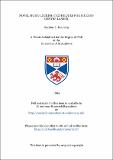Novel mode-locking techniques for colour-centre lasers
Abstract
The work reported in this thesis is primarily concerned with the generation of ultrashort pulses from a NaCl:OH- colour-centre laser. Active mode locking of the NaCl:OH- laser by synchronous pumping and acousto-optic loss modulation was characterised in detail. Synchronously mode-locked pulses of 8 ps duration were compressed to 250 fs in an anomalously-dispersive optical fibre and a novel soliton-effect pulse compressor was constructed from a nonlinear fibre-loop mirror. Using this device, the synchronously mode-locked pulses were compressed to 300 fs with no discernible background radiation. The NaChOH- laser was coupled-cavity-mode locked using both nonlinear Fabry- Perot and Michelson cavity configurations, and pulses of 110 fs duration were obtained. A sawtooth amplitude modulation of the laser output was observed. This modulation, which arose from the beating of the mode-locked Nd:YAG pump laser and NaCl:OH- laser pulse trains, was avoided by frequency-referencing the colour-centre laser to the pump laser. A characterisation of the phase noise of the frequency-referenced, coupled-cavity mode- locked laser was performed. By replacing the frequency synthesiser for the pump laser mode locker with a crystal oscillator, the phase noise of both the Nd:YAG pump laser and the NaCl:OH- colour-centre laser were reduced by two orders of magnitude. The technique of self-mode locking was successfully applied to the NaCl:OH- laser. For this laser, it was necessary to include a rod of high-nonlinearity lead-silicate glass in the laser cavity to achieve sufficient self focusing for self-mode locking. Stable mode-locking was initiated by a regenerative acousto-optic modulation and pulses of 95 fs were obtained. The thesis concludes with descriptions of some experiments performed using a mode-locked NaCl:OH- laser and a KCl:TiO(1) colour-centre laser. Efficient pulsed Raman amplification in an optical fibre was achieved by using an optical fibre thats group-velocity dispersion was the same for both the pump and signal wavelengths. By co-propagating pulse trains from the KCl:TiO(1) and NaCl:OH- lasers through a semiconductor optical amplifier cross phase modulation was observed. Ultrafast all-optical switching using the nonlinearity at half the bandgap was demonstrated for an GaA1As integrated interferometer. This nonlinearity was subsequently used to coupled-cavity mode lock the KCl:TiO(1) colour-centre laser.
Type
Thesis, PhD Doctor of Philosophy
Collections
Items in the St Andrews Research Repository are protected by copyright, with all rights reserved, unless otherwise indicated.

